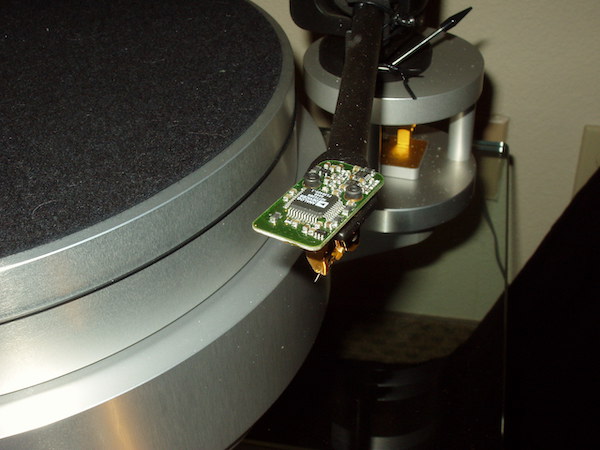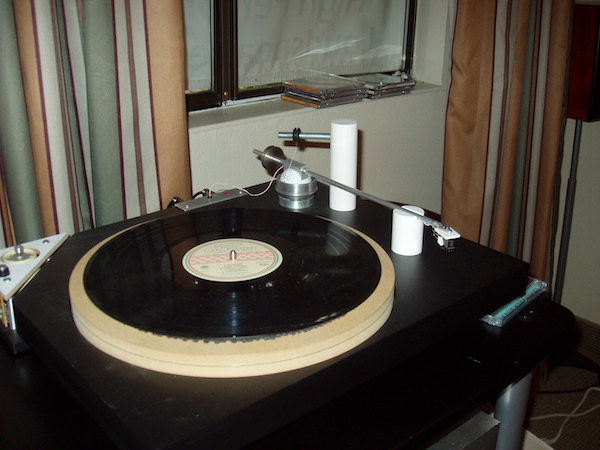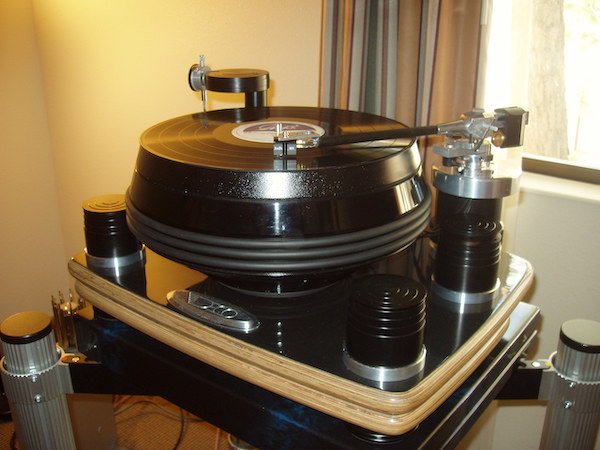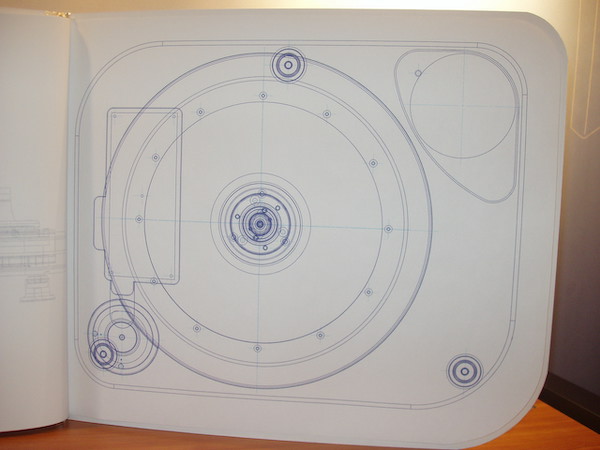Analog Corner #117

The 2005 Consumer Electronics Show
What if they gave a CES seminar titled “Can You Hear Me Now? Where Has Audio Gone?” and almost no one showed up? That’s pretty much what happened in January, “they” being me.
The Consumer Electronics Association, which each January holds its Consumer Electronics Show in Las Vegas, Nevada, seemed finally to have taken notice of the low esteem in which good sound is held in America. It wasn’t alone in noticing this, as you’ll read later in this column and elsewhere in Stereophile’s online CES coverage and in next month’s report.
I was assigned to moderate and to suggest participants for the Friday-afternoon session, held in a North Hall meeting room at the main venue, the Las Vegas Convention Center. At least we wouldn’t be preaching to the converted at the Alexis Park Hotel, where the CEA traditionally houses makers of high-end audio equipment. Scheduled to participate in my panel discussion were veteran audio journalist Ken Kessler, Blue Man Group producer Todd Perlmutter, CEA director of industry analysis Sean Wargo, recording engineer Elliot Mazer (Neil Young, etc.), Quartet Marketing Group’s Stirling Trayle (importer of T+A and Amphion and formerly with Sumiko), and Geir R. Skaaden, CEO of Neural Audio, a pro-audio company providing 5.1-channel digital signal-processing (DSP) technology to radio broadcasters transitioning from two-channel audio.

A total of 25 people attended, including Stereophile’s John Atkinson, Naim America’s Chris Koster, and other familiar faces; there were only a few unknowns. The room we’d been assigned was the Convention Center’s most out-of-the-way cul de sac. When I got to the speakers’ “ready” room before the event, the day’s event grid showed four seminars running in each of 13 conference rooms. Not one of them was my seminar. I turned to the hidden second page, where a lone, skinny column on the otherwise empty sheet listed four additional seminars taking place in a 14th room, one of which was mine.
The morning’s first event was titled “The End of Analog.” Judging by what I saw at the Alexis Park and the outboarding T.H.E. Show at the adjacent St. Tropez hotel, I don’t think so. However, between the downer title assigned to my seminar (compared to such provocative titles as “Battle for Control of the Digital Living Room”), the location, and the mainstream US audio press’s—not to mention retailers’—utter lack of interest in audio, the sparse attendance was hardly surprising.
The CEA had insisted on the participation of Sean Wargo, who, I was told, would give a PowerPoint presentation outlining the organization’s research into the state of audio. By the end of December I’d received a copy, but I didn’t memorize the details because Wargo would be presenting it with his own live commentary. A few minutes before the seminar began, he arrived to tell me that he’d been double-booked and would neither participate in the seminar nor present the slide show. Then I heard about the closing of Quantegy, the last remaining US manufacturer of analog recording tape. It was that kind of afternoon.
The Death of Analog? Not This Year
Over at the Alexis Park, where “high performance” audio1 held sway, the good news was more analog: more turntables, more phono preamps, more gizmos, and, especially, more vinyl. More important, everyone with whom I spoke claimed “More analog sales!” Acoustic Sounds’ Chad Kassem told me, “We’re selling more vinyl than ever, we’re selling more SACDs than ever, and we’re selling more DVD-As than ever. And more equipment. The only decline in my business is CDs, and I just say good riddance! So things are good!” That’s pretty much what everyone said, though with less Crescent City drawl.
I begin my analog coverage of CES with a digital product: a fully balanced, 24-bit/768kHz A/D converter from Behold in Germany that weighs 4.2gm and is mounted to a tonearm’s headshell. The arm would have to be rewired with a single, lightweight digital cable terminated in Behold’s MCK768 master clock, a small device that fits at the base of the arm. The signal then travels (up to 10m with no loss) via 50-ohm coax cable to an SDI768 serial data input of Behold’s APU768 digital preamplifier, where phono EQ takes place in the digital domain. You can have RIAA, IEC, or any curve—including custom ones—available as easily selected presets.

But what if you don’t want to rewire your tonearm or buy a digital preamp? And anyway, why would you want to digitize your analog rig? As explained to me by Acoustic Signature turntable designer Gunther Frohnhöfer, who is also general manager of Ballman, which manufactures Behold, there will also be an outboard A/D processing box that he’s developing in conjunction with Behold—and which he showed me sans enclosure. You plug your arm’s analog cables into it via RCA jacks, and the preamplification, 24/768 processing, and equalization all occur inside the box. Connect the box to your PC and load Behold’s software and you can choose RIAA, IEC, or whatever EQ curve you wish, including custom ones. Outputs include analog, 24/192 for use with hi-rez digital processors or archiving to DVD (and, in the future, to Blu-ray and/or HD DVD), and 16/44.1 for burning to CDs, iPods, etc. The outboard version will also feature a precision, DSP-driven, AC synchronous motor controller and a signal-sensing circuit that will automatically shut off the turntable motor at the end of play.
Two big advantages of this arrangement are precise digital-domain EQ with no capacitors or other components subject to value fluctuation, and the advantages of multiple EQ without the potential sonic degradation caused by switches and other circuit routing. That said, what about the effects of digitization? I can’t wait to hear what the tradeoffs might be. I’m not against digital, but I am against bad sound. At around $2000, the Behold box could be an amazing innovation. Or it could make your records sound “perfect”—just like CDs.
The weak dollar continues to pressure foreign manufacturers and distributors of analog equipment to develop products that can remain competitive. For instance, Acoustic Signature’s new Challenger turntable uses the same robust bearing and massive aluminum platter as their more expensive Final Tool, which I reviewed and loved (Stereophile, September 2001, Vol.24 No.9), but overall is somewhat smaller. Still, it features a Rega RB250 tonearm and an outboard motor and AC synthesizing power supply—all for around $1600. Since severing its relationship with Thorens, Acoustic Signature has also introduced the acrylic-plinthed Crystal turntable ($1400)—a more traditional design aimed at a different segment of the market.
Thorens itself, meanwhile, has found another supplier—a good thing, considering that Trian Electronics, their American distributor, doubled Thorens’ sales in 2004. With interest growing at the bottom of the turntable market, Thorens has introduced the TD-240, a three-speed, belt-driven model with a tonearm reminiscent of the last-generation Dual, and the great-sounding Audio-Technica AT95E cartridge, all for $899—and, for $399, the two-speed, belt-driven TD-158, with Dual cartridge. The TD-158 is aimed at chain stores, which have shown a renewed interest in analog. Also from Thorens is the TD-2030 with your choice of tonearms: Rega RB250 ($3299), SME M2 ($4999), or SME 309 ($5499).
Noted electronics designer Tim de Paravicini has also gotten into spinning class, with a new, as yet unnamed, but intriguing-looking turntable featuring a magnetically levitated platter and bearing, a sprocketed belt, and a double armboard. It’ll sell for “about” $10,000. Also in distributor Dan Meinwald’s EAR USA room was de Paravicini’s new 912 all-tube preamp with built-in moving-magnet and transformer-based moving-coil preamp (ca $10,000). EAR USA also showed the new 88PB, a standalone phono preamp that includes “more or less” what’s in the 912 and two pairs of inputs, one of which includes a switchable transformer for low-output cartridges (ca $4000). A hot-looking Redpoint Testa Rossa ’table ($11,000) sat above the electronics on a custom HRS isolation base.
The dollar’s slide has pushed Clearaudio to develop the new Champion Magnum turntable with Satisfy tonearm ($3200–$3500); they also had prototype Satisfy armtubes of wood and carbon fiber. Also new from Clearaudio were three cartridges: the Goldfinger ($8000), Titanium ($5000), and Stradivari ($3000). Clearaudio importer Musical Surroundings debuted the Super Nova ($2400), Michael Yee’s latest battery-powered phono preamp, which features three independently configurable inputs and an attenuator for direct-to-amp connection. Other new gear in the Musical Surroundings room: the Benz Micro Ebony high-output (2.5mV) cartridge ($3000); MS’s own adjustable step-up transformer (under $2000), designed by Art Audio’s Kevin Carter and featuring Lundahl transformers, which Carter imports to America; a new “both sides now” record cleaner, the Clearaudio Matrix ($4500); and Graham Engineering’s Phantom tonearm ($3900).
A few doors down, American-made Basis, no longer distributed by Musical Surroundings, introduced a VTA-adjuster upgrade for its $3750 Vector tonearm, and again displayed its Work of Art turntable—but this year they actually allowed photos to be taken of the 400-lb, $60,000 beauty.

Over at Axiss Marketing>Trans-Rotor Atlantis, another turntable designed to defend its brand’s market share against the dropping dollar. The Atlantis includes an outboard power supply for its AC synchronous motor and will sell for $3500 with tonearm. Manzano also showed me the new Trans-Rotor Reference turntable power supply ($7500).
Stanalog Audio’s George Stanwick informed me that the Well Tempered Lab line (www.welltemperedlab.com), which he now owns and distributes, had an outstanding 2004, thanks in part to the dollar’s decline. The turntable line, manufactured in Maine, includes the entry-level Well Tempered ($2500), the Classic ($4000), and the Reference ($6500), each of which includes a version of the Well Tempered Arm. Platter and arm upgrades are also available, and because WT tonearms are interchangeable with Regas, they’re available separately as upgrades for Rega and other ’tables using the popular Rega arms.
Well Tempered founder and designer Bill Firebaugh’s not finished with analog. His new turntable has a Well Tempered–like arm that uses a golf ball as a “bearing.” The plan is to sell the ’table, with MDF platter and phono preamp, for around $1000.

AudioNote’s TT3 Reference turntable, shown in prototype form last year, is now available for $25,000 without tonearm. Each of the three motors has its own power supply, and together they output 2.5 horsepower. The suspension’s resonant frequency is appropriately low at 2.4Hz. The ’table can take up to three tonearms simultaneously, but only AudioNote’s proprietary arm can be used. The arm is available in various versions priced from $4000 “up to $8000 or $9000.”

Avid (now distributed by Music Direct) introduced the new Diva turntable ($2500). Designer Conrad Maas, looking uncharacteristically spiffy in suit and tie, ran me through the Diva’s particulars: same bearing system as in his more expensive ’tables, including a tungsten-carbide ball, cut-sapphire thrust plate, and the same three-point suspension, which offers “perfect” balance and pistonic vertical motion. Maas proved it by pushing down on the platter as a record played. The stylus never budged from its appointed rounds. A second 9" or 12" arm can be added if you also spring for the special platform and connecting rods ($100). Roksan’s talented turntable designer, Touraj Moghaddam, ran me through the company’s latest ’tables, including the Xerxes XX (upgraded from the X), as well as an upgraded isolation plinth, made of marine birch-ply laminate and aluminum, for both Xerxes models and the top-of-the-line TMS. Screw a ’table into the elastomer feet attached to the new, light, rigid support, and attach feet, cones, or other decouplers or grounding devices to the support’s underside. Roksan’s best seller is the new combo of Radius 5 ’table and Nima arm ($1600 with Roksan Chorus cartridge). A review sample should be forthcoming.
Longtime vinyl enthusiast Vladimir Lamm usually brings a vintage EMT transcription ’table to shows. This year he brought a gorgeous Final Labs Parthenon 2052 ($22,000) fitted with an Ikeda IT407 arm ($2500), which he’s importing through Damoka LLC, a new company he’s recently incorporated.
Loricraft’s Terry O’Sullivan showed me their gorgeous new 501 turntable, imported and distributed by Smart Devices. For the time being, because of trademark issues, Loricraft can’t use the Garrard name in the US. The 501 is not a reconditioned vintage Garrard but a complete rethinking of the iconic, idler-wheel–driven 301 and 401 ’tables from the English manufacturer. Loricraft uses a new, proprietary Aroflux motor with flying-thrust bearing that itself might require an entire column to describe in detail. Lots of sweat, tears, and stainless steel have gone into Garrard’s resurrection. I look forward to a listen very soon.
A genuine, vintage, Shindo-modified Garrard 301 was the centerpiece of the Shindo–DeVore room, where John DeVore’s new, compact, floorstanding Gibbon Super 8 loudspeakers ($4000/pair), driven by Shindo electronics, made some of the best music I heard at CES regardless of price. Ken Shindo’s Garrard mod includes upgrades of the platter, bearing, plinth, arm, cartridge, and isolation feet. At the show’s conclusion, at the suggestion of an unnamed individual, DeVore and Shindo importer Jonathan Halpern stored their gear in a “secure” room for pickup by the freight forwarders. Most of their stuff, including some priceless LPs, were stolen in what sounds like an inside job.
In more pleasant news, Music Hall introduced a Ferrari-red limited edition of its 2.1 turntable for $399. Judging by the Pro-Ject turntables shown on the Sumiko booth, displayed at the Las Vegas Convention Center, the Pro-Ject factory in the Czech Republic, where Music Hall’s ’tables are made, has been busy. Pro-Ject’s new Debut 3 features a notably improved arm, a better finish, and a price of $299 in basic black. The new 1 Xpression has a carbon-fiber arm, a cast aluminum platter, an improved plinth, and a Sumiko Oyster cartridge, all for $429. The new 2 Xperience features a clear acrylic plinth, a platter of MDF-vinyl composite, an upgraded carbon-fiber arm, polymer-insert isolation feet, and, for a limited time, a Sumiko Pearl cartridge, all for $999. Pro-Ject’s popular Perspective turntable is now the Perspective 2 ($1299), with improvements in its bearing and suspension and a significant upgrade of its 9C carbon-fiber arm. Sumiko also displayed Pro-Ject’s Speed Box electronic speed controller ($299) and Primare’s R20, a moving-coil/magnet phono preamp ($695).
The two most exciting new analog rigs at CES were from a familiar name, Nottingham Analogue Audio, and a new outfit, Australia’s Continuum Audio Labs. Nottingham’s Tom Fletcher ran me through the new Deco turntable, complete with outboard power supply but no tonearm. The Deco is about mass and more mass, plus, as can be seen from the contouring at the bottom of its platter, dissipation of vibrational energy created at the interface of stylus and groove. Shipping alone must account for a hefty chunk of the $33,999 price. For that kind of money I’d expect, at the very least, rock-solid speed stability, screaming dynamic contrasts, 3D image focus, and all the other goods one expects from a top-end ’table—plus, of course, musical grace and communication. Nottingham turntables are distributed in the US by Audiophile Systems.

Australia's Continuum Audio Labs’ Caliburn is something new under the sun. While the Nottingham ’table is called the Deco, the Caliburn looks deco—but there’s nothing old-fashioned about its design or execution. Its 80-lb, proprietary, magnesium-alloy platter is magnetically levitated—it exerts only about 2 lbs of pressure on the ceramic bearing. The platter is actually two platters “nested,” with an inverted cup bearing of cast alloys and ceramics. There are also a “computer-enhanced” chassis of magnesium alloy, and a zero-cogging, battery-powered (or low-noise wall-powered), linear-controlled, brushless DC servo-motor with patented coil technology said to produce 0.006% real-time speed error. “The pulley absolutely does not vibrate,” I was assured. The Caliburn’s platter features a familiar-looking vacuum hold-down system with a miniature, magnetic ferrofluid, rotary sealed shaft that allows the pump to be shut off once a sufficient seal is established. The three-speed motor controller can be adjusted, and the platter is quickly brought up to speed (without manual help), then drops down to low-torque mode. Round or flat drive belts of rubber, cotton, Mylar, or other materials can be used.

The Caliburn’s magnetically attracted, direct-coupled armboard—magnetically shielded, of course—is claimed to offer 60dB of noise reduction. The unusual-looking arm was designed using Finite Element computer analysis, and is said to offer superior damping and stiffness as well as low mass. VTA and azimuth are adjustable on the fly. The VTA adjuster uses a triangulated mechanism that avoids the more standard “grub” screw and shaft, for greater accuracy. The dual-cam antiskating system (patent pending) continuously varies the antiskating force as the stylus traverses the record surface. The arm itself is woven, in a proprietary helical pattern, partly of sisal hemp, which was found to combine strength similar to Kevlar’s but with a higher damping factor. It takes 12 hours to weave the fibers around a special foam core, which is then bound in resin, much as a surfboard is. The Caliburn can also handle Graham or SME tonearms, as well as linear trackers.
There is nothing lightweight about the care, precision, and science that have gone into the design of the Australia Continuum Audio Lab Caliburn. The ’table will cost about $38,000, the arm ca $12,000. That CES system, in the Stereovox room, also included a Lyra Olympus cartridge (limited edition), Peak-Consult speakers linked with Stereovox cable, and Wavac electronics: the three-box LCR X2 phono preamp ($25,000), PR-T1 line stage, and HE-833 v1.3 amplifiers. The Caliburn turntable may be the most musical and highly resolving I’ve ever heard. I’ll find out for sure after Home Entertainment 2005.
Believe it or not . . .
. . . there was still more new analog at CES 2005, including these turntables: China-based Opera Audio’s suave-looking Consonance Droplet LP-5.0 ($4000 without arm), MEL’s Go Eli ($5465), and Blue Note’s Bellagio ($5000, plus $2500 for a Betania arm). I hope I didn’t omit any new designs—I could go on with already-in-production models from VPI, SOTA, Kuzma, Teres, and other familiar brands. There were so many at this show you’d have thought it was 1985, not 2005.
I got a glimpse, in blueprint form, of an innovative new turntable from Immedia’s Allen Perkins, who for some reason was out of the ’table business for a few years, after building some outstandingly ingenious and popular designs that culminated in the Revolution, the Japanese demand for which outstripped his ability to deliver. The new ’table (later branded “Spiral Groove”) will be like its designer: understated, self-effacing, and very complex. Meanwhile, Perkins’ RPM-2 tonearm, one of my references and widely copied by other manufacturers, remains in production, awaiting the new ’table. Immedia also imports the line of equipment stands made by German firm Finite Elemente, who introduced two new wall-mount shelves for turntables.

Still not finished. I saw and heard Audio Research’s new hybrid (JFETs with 6922 tubes) PH5 phono section, which features remote-control loading ($1995). Hovland showed the new P-200 solid-state MC/MM phono board ($2000), designed for their snazzy-looking HP-200 preamp. The new board has adjustable loading and gain and a dedicated internal power supply. Other phono sections I ran into included Vitus Audio’s battery-powered Statement phono preamp (ca $12,000); Grommes’ two-box, vacuum-tubed Phono 8 (ca $2400), which includes continuous variable loading; Ensemble’s Fonobrio MM/MC (Ensemble is now imported by Lombardi Sales, www.rayofsound.com); and Einstein’s gorgeous The Turntable’s Choice ($5100). (The highly regarded Einstein line is imported from Germany by Audio Imports, www.audioimports.com.) Finally, there was the ultracompact, ultracool Communique hybrid design, offering 70dB of gain, marble damping, a separate dual-mono power supply, and a custom wood finish (ca $7000). “A sweet little thing,” said designer Robert Wakeling.
A Little Business Before Concluding Business
Mørch tonearms, Eurolab turntables (whose founder and designer, Thomas Scheu, died last December), and Lehmann phono preamps are now imported by Hudson Audio Imports (www.hudsonaudio.net). The ELP laser turntable is now available through Audio Turntable Ltd. of St. Albans, Vermont (sales@audioturntable.com).
Some Music: Live and Recorded
At Classic Records’ annual press event, label chief Mike Hobson announced the importation of the Blue Danube line of record-cleaning machines, which I’ve been writing about enthusiastically for years. They’re worth the wait. There are now three models in the lineup: the Flüsterbär, the Micro, and the Aragon. The build quality and fit’n’finish are absolutely stunning, and I hope to review one or more of them soon.
Hobson has released Patricia Barber’s latest Blue Note album, Live a Fortnight in France, as a two-LP set. (Barber is this decade’s Jennifer Warnes; Mobile Fidelity issued Barber’s Companion at CES as a 45rpm boxed set.) He also announced a new record label, Straight Ahead, in conjunction with veteran mastering engineer Bernie Grundman; the first release will be Hugh Masekela’s Almost Like Being in Jazz, on vinyl twofer and DualDisc. Finally, Hobson dropped his big bomb: Over the next year he’ll release the entire Who catalog on 200gm Quiex SV-P vinyl, beginning with Who’s Next—which was included in the press kit. Ken Kessler and I each got signed test pressings, but Classic’s usual contest—in which we are told the original release’s catalog number and have to then guess the album’s title—was busted this year because I’d caught a glimpse of the Who album in a rack at the back of the room.
Other than that, well, gee—I guess analog was dead at CES 2005.
Footnote
1. Whoever at the CEA chose that phrase and put it on the Alexis Park marquee gets props from me. It beats “high-end”—and especially “high-priced”—hands down. [The first person I heard using the phrase “high-performance audio” some years to describe our shared passion was AudioQuest’s Bill Low.—JA.]
Sidebar: In Heavy Rotation
1) Sufjan Stevens, Michigan, the Great Lakes State, Asthmatic Kitty LPs (2)
2) Jimi Hendrix, Live at Woodstock, Classic 200gm SV-P Quiex LPs (3), 7" 45rpm (1)
3) Duke Ellington, Piano in the Background, Classic 200gm Quiex SV-P LP
4) The Who, Who’s Next, Classic 200gm Quiex SV-P LP
5) The Libertines, The Libertines, Rough Trade import LP
6) Joan Baez, In Concert, Cisco 180gm LP
7) Patricia Barber, Café Blue, Mobile Fidelity 180gm 45rpm LPs (3)
8) Mary Black, By the Time It Gets Dark, Dara/Vivante 180gm LP
9) Eleanor McEvoy, Early Hours, Mosco 180gm LP
10) Judee Sill, Judee Sill, 4 Men With Beards 180gm LP






















































